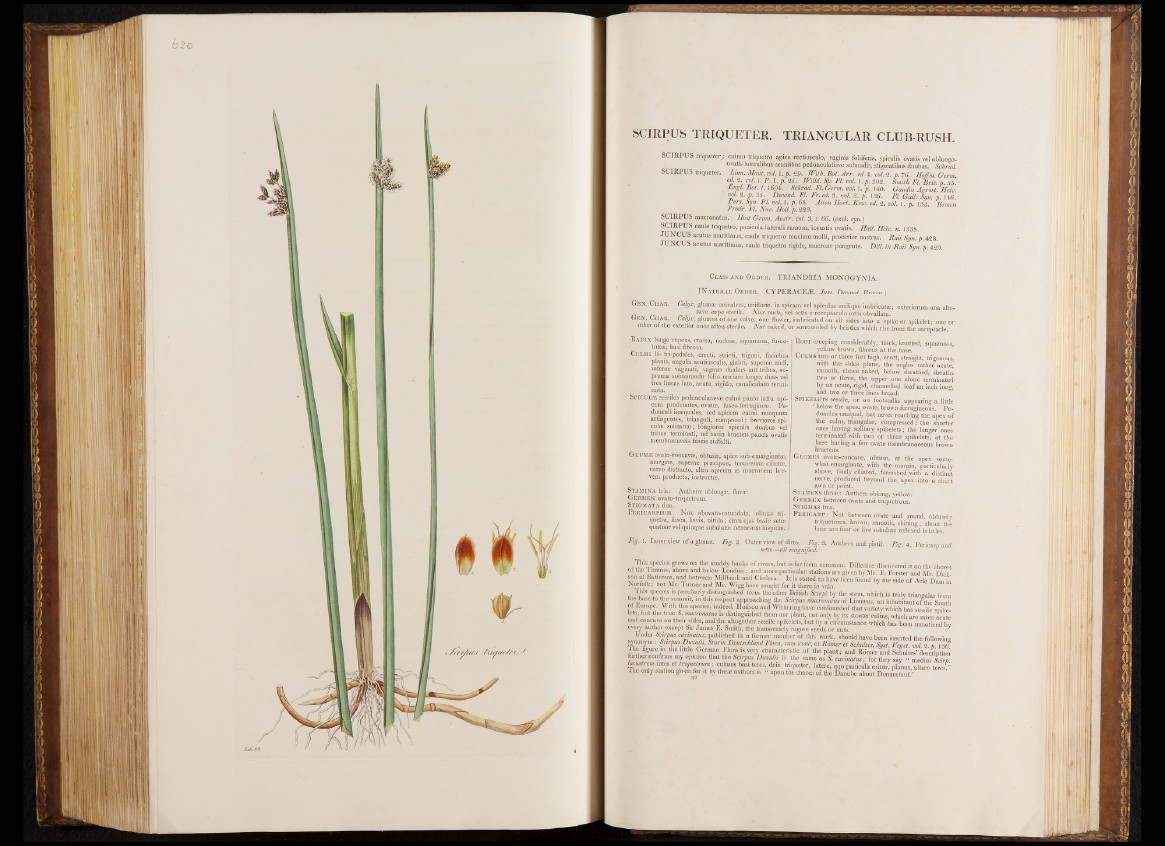
SCIRPUS TRIQUETER. TRIANGULAR CLUB-RUSH.
SCIRPUS triqueter; culmo triquetro apice rectiusculo, vaginis foliiferis, spiculis ovatis vel oblonco-
ovatis lateralibus sessilibus pedunculatisve subnudis, stigmatibus duobus. Schrad.
SCIRPUS triqueter. Linn. Mant. vol. 1. p . 29- With. Bot. Arr. ed. 4. vol. 2. p. 76. HofFm. Germ.
ed. 2. vol. I. P. I. p. 25. Willd. Sp. PI. vol. l .p . 302. Smith FI. Brit. p. 55.
Lngl. Bot. t. 1694. Sehr ad. FI. Germ. vol. l . p . 140. Gaudin Agrost. Helv.
vol. 2. p. 35. Decand. FI. Fr.ed. 3. vol. 3. p. 136. FI. Gall. Syn. p . 146.
Fers. Syn. Pi. vol. 1. p. 68. Alton Hort. Kew. ed. 2. vol. l. p. 132. Brown
Prodr. FI. Nov. Holl. p . 223.
SCIRPUS mucronatus. Host Gram. Austr. vol. 3. t. 66. (excl. syn.)
SCIRPUS caule triquetro, pauicula laterali ramosa, locustis ovatis. Hall. Helv. n. 1338.
JUNCUS acutus maritimus, caule triquetro maxirno molli, procerior nostras. Rail Syn. p . 428.
JUNCUS acutus maritimus, caule triquetro rigido, mucrone pungente. Dill, in Raii Syn.p. 429.
Class a n d Ord e r . TRIANDRIA MONOGYNIA.
[N atural O rder. CYPERACEjE, J uss. Decand. Brawn.']
G e n . Cha r. Calyx, glum® univalves, uniflorte, in spicam vel spiculas undique imbricate; exteriorura una alte-
. rave sajpe sterili. Nux nuda, vel setis e receptaculo ortis obvallata.
G e n . Ch a r ., Calyx, glumes of one valve, one flower, imbricated on all sides into a spike dr spikelet; one or
other of the exterior ones often sterile. Nut naked, or surrounded by bristles which rise from the receptacle.
Ra dix longe repens, crassa, nodosa, squamosa, fusco-
lutea,. basi fibrosa.
Culmi bi- tri-pedales, erecti, stricti, trigoni, faciebus
plan is, angulis acutiusculis, glabri, superne nudi,
inferne vaginati, vaginis duabus aut tribus, su-
prema solummodo folio unciam Iongo, duas vel
tres lineas lato, acuto, rigido, canaliculate terminate.
Sp ic u iæ sessiles pedunculateve culmi paulo infra api-
, cem prodeuntes, ovate, fuseo-ferrugineæ. Pe-
dunculi inæquales, sed apicem culmi nynquam
attingentes, trianguli, compressi ; breviores' spiculas
solitarias ; longiores spiculis duabus vel
tribus terminati, ad basin bracteis paucis ovatis
membranaceis fuscis suffulti.
G lumæ ovato-concavæ, obtusæ, apice sub-emargînate,
margine, superne prascipue, tenuissime ciliatoe,
. nervo distincte, ultra apicem in mucronem brevem
producto, instructie.
Stamina tria: Antheras oblongse, flavse.
G ermen ovato-triquetrum.
Stigmata duo.
Pericarpium : Nux obovato-rotundata, obtuse tri-
quetra, fusca, lævis, nitida; circaejus basin setos
quatuor vel quinque subulate retrorsum hispidæ. I
Fig. 1. Inner view o f a glui
Root creeping considerably, thick, knotted, squamose,
yellow brown, fibrous a t the base.
Culms two or three feet high, erect, straight, trigonous,
with the sides plane, the angles rather acute,
smooth, above naked, below sheathed, sheaths
two or three, the upper one alone terminated
by an acute, rigid, channelled leaf an inch long,
and two or three lines broad.
Spik e l e t s sessile, or on footstalks appearing a little
below the apex, ovate, brown-ferrugineous. Peduncles
unequal, but never reaching the apex of
the culm, triangular, compressed; the shorter
ones having solitary spikelets; the longer ones
terminated with two or three spikelets, at the
base having a few ovate membranaceous brown
bracteas.
G lumes ovato-concave, obtuse, at the apex somewhat
emarginate, with the margin, particularly
above, finely ciliated, furnished with a distinct
nerve, produced beyond. the apex into a short
awn or point.
Stamens three Anthers oblong, yellow.
G e rmen between ovate and triquetrous.
Stigmas two.
P e r ica r p : Nut between ovate and round, obtusely
triquetrous, brown, smooth, shining; about the
base are four or five subulate reflexed bristles.
Fig. 2. Outer view of ditto. Fig. 8. Anthers and pistil. Fig. 4. Pericarp and
sete—all magnified.
This species grows on the muddy banks of rivers, but is fer from common. Dillenios discovered it on the shores
of the Thames, above and below London; and more par ticular stations are given by Mr. E. Forster and Mr Dick
son at Battersea, and between Millbank and Chelsea. It is stated to have been found by the side of Acle Dam in
Norfolk; but Mr. Turner and Mr. Wigghave sought for it there in vain.
This species is peculiarly distinguished from the other British Scirpi by the stem, which is truly triangular from
the base to, the summit, in this respect approaching the Scirpus mucronatus of Linmnus, an inhabitant of the South
of Europe. With this species, indeed, Hudson and Withering have confounded that variety which has sessile snike
letsi but the true S. mucronatm is distinguished from our plant, not only by its stouter culms, which are more acute
l„be'r.? d“ ' ant* the altogether sessile spikelets, but by a circumstance which has been unnoticed by
every author except Sn James E. Smith, the transversely rugose seeds or nuts *
Under Scbpus carimtu,, published in a former number of this work, should.have been inserted the following
synonym: Sci^us D m h i , Sturm Deutschland Flora, cum icone, et Komer a Schultes, Spot. Veget. ml. 2 . p 136°
The figure in the little German Flora is very characteristic of the plant;, and Romer and Schultes’ description
further confirms my opinion that the Scirpus Dmaln is the same as S. carimtus; for they say “ medius Sciro
T h f r ,.r‘Juf rT i c"lmus h f 1 ‘«os. dem triqueter, latere, quo pauicula oritur, planus, altero teresf”
The only station given for it by these authors is “ upon the shores of the Danube about Donaustauf.”